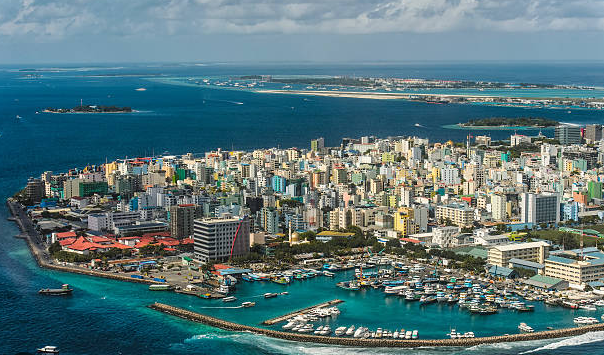The rising sea levels and depletion of drinking water in the Indian Ocean archipelago threatens to swamp the Maldives. President Mohamed Muizzu has although waved off the need to relocate and promises that the low-lying nation will beat the waves through ambitious land reclamation and building higher islands.
“If we need to increase the area for living or other economic activity, we can do that,” Muizzu told news agency AFP, speaking from the crowded capital Male, which is ringed with concrete sea walls. “We are self-sufficient to look after ourselves.”
Sea walls will ensure risk areas can be “categorized as a safe island”, he said.
“I can categorically say that we definitely don’t need to buy land or even lease land from any country,” Muizzu said.
Environmental regulations
In a recent report, Human Rights Watch (HRW) accused the authorities of failing to implement their own environmental regulations, saying reclamation projects were “often rushed” and lacked proper mitigation policies.

Ahmed Fizal, who heads the environmental campaign group Marine Journal Maldives (MJM), said he feared that politicians and businessmen would see shallow lagoons as potential reclamation sites to turn a quick profit.
The chain of 1,192 tiny islands has found itself on the frontlines of the climate crisis, battling for survival in the last few years.
80 per cent of the Maldives is less than a meter above sea level and while fortress-like walls ringing tightly-packed settlements can keep the waves at bay, it is uncertain as till when these walls will be able to protect the citizens. The fate of the beach islands that attracts tourists is uncertain still, given that tourism contributes to a large part of the economy.
Environmental and rights groups have warned that the project could even exacerbate flooding risks.
First Environmental Refugees
Former president Mohamed Nasheed began his administration 15 years ago warning citizens they might become the world’s first environmental refugees needing relocation to another country.
Nasheed’s predecessor, Maumoon Abdul Gayoom, was the first to ring the alarm of the possible “death of a nation”, warning the United Nations in 1985 of the threat posed by rising sea levels linked to climate change.
The UN’s Intergovernmental Panel on Climate Change (IPCC) warned in 2007 that rises of 18 to 59 centimeters would make the Maldives virtually uninhabitable by the end of the century.
Drinking Water Depletion
“Every island in the Maldives has run out of fresh water,” said Shauna Aminath, 38, the Environment Minister until last week, when Muizzu’s government took power.
Almost all of the 187 inhabited islets in the archipelago depend on expensive desalination plants, she told AFP.
“Finding ways as to how we protect our islands has been a huge part of how we are trying to adapt to these changes,” Aminath said.
With the President taking matters in his hands, claiming that relocation would not be necessary has put the citizens in quiet a situation. As Maldives grapples with the urgent need for adaptation to climate change, the delicate balance between economic development and environmental preservation remains a critical challenge.











Comments 1